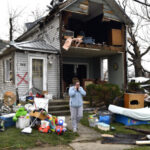Wind-driven water like that occurring during Hurricane Irene penetrates openings in residential roofs but roof decks seams can be sealed to prevent damage, according to tests by an insurance home safety institute.
The Insurance Institute for Business & Home Safety (IBHS) has conducted a full-scale research test program of how wind-driven water, such as that occurring during hurricanes, penetrates openings in residential roof systems at the IBHS Research Center in South Carolina.
“Wind-driven rain that gets into a house through openings in the roof can collapse ceilings and cause extensive damage to interior finishes, furnishings and other family possessions,” said Julie Rochman, president and CEO, IBHS. “The testing conducted by our engineers at the IBHS Research Center clearly demonstrated that water penetration during hurricanes could be substantially reduced by sealing the roof deck seams.”
For new construction or re-roofing, roof deck seams can be sealed from the exterior using a modified bitumen tape. For retrofitting when the roof cover is not replaced, homeowners can seal the roof deck seams from the inside with a closed-cell foam spray adhesive.
IBHS researchers built a 1,300 sq. ft., single-story duplex test building with construction features common in many coastal and inland areas of the Atlantic and Gulf Coast states with hurricane exposure. The interior of the duplex was furnished with light fixtures, ceiling fans, furniture, carpeting and laminate flooring made to look like wood. Both sides of the duplex roof were identical, with the critical exception of using modified bitumen tape to seal the between-sheathing joints and gaps on one side of the roof.
The building was placed inside the 21,000 sq. ft. test chamber at the IBHS Research Center and subjected to several individual test sequences involving both high-speed, multi-directional, gusty winds and prolonged exposure to “rain” typical during a hurricane, delivered at a rate of up to 8 inches per hour.
During the testing, 24 cameras were placed inside the test specimen to capture the water entering the duplex. Video footage of the interior of both sides of the building showed water entering the side with the unsealed roof deck, streaming off of light fixtures and ceiling fans. Approximately 30 minutes after the completion of the test, pieces of the ceiling on the unsealed side began to collapse.
“As the attic insulation became saturated, the water began to soak into the ceiling gypsum wallboard,” said Dr. Anne Cope, IBHS research director. “The combination of the weight of the saturated insulation and the weakened gypsum wallboard caused the ceiling to collapse in three places on the unsealed side of the home. However, on the sealed side of the duplex the ceiling did not collapse and there was much less water entry.
“In the real world, a family would be uprooted from the home without the sealed roof deck potentially for months while repairs were made,” Cope said. “However, a family living in the home with the sealed roof deck could probably stay in the home while repairs were made, and if they did have to leave they would likely be able to return to the home much sooner.”
Following the test, IBHS brought in a claims adjuster from a local insurance company who is trained in catastrophe claims adjusting to estimate the amount of damage each house suffered. He assessed the damage to the front three rooms on both sides of the duplex, including the kitchen, dining room, and family room. During a hurricane or high wind event, winds generally come from a relatively small range of directions after the roof cover blows off, so damaged confined to one area of a house would be typical of most people’s experience.
According to the adjuster’s report, estimated damage on the unsealed side totaled nearly $17,000, while estimated damage on the sealed side totaled approximately $5,400. This is a substantial difference totaling almost three times as much for the side of the duplex with the unsealed roof deck. Of particular note is that the furniture in the side with the unsealed roof deck had to be replaced, while the furnishings in the side with the sealed roof deck only had to be cleaned.
“The moment water enters your home you have a potentially catastrophic loss waiting to happen,” said Rochman. “Water travels along beams, through electrical conduits, along wiring, and into walls, ceilings and floors; in other words, it can get just about everywhere, so keeping it out in the first place is the homeowner’s best bet for preventing damage.
“Sealing the roof deck can significantly strengthen this critical part of a home and reduce the chances of a catastrophic loss due to water damage when the roof covering is compromised or blown off entirely during a high-wind event. And taping the seams on an average-sized roof costs only about $500 – a great, relatively small investment that could pay huge dividends when a storm hits,” she added.
IBHS has produced a demonstration video on sealed roof decks that can be viewed here.
Was this article valuable?
Here are more articles you may enjoy.

 Gallagher: Global Insured Natural Disaster Claims Again Dominated by Severe U.S. Storms
Gallagher: Global Insured Natural Disaster Claims Again Dominated by Severe U.S. Storms  California Chiropractor Sentenced to 54 Years for $150M Workers’ Comp Scheme
California Chiropractor Sentenced to 54 Years for $150M Workers’ Comp Scheme  Florida’s Home Insurance Industry May Be Worse Than Anyone Realizes
Florida’s Home Insurance Industry May Be Worse Than Anyone Realizes  Report Using Aerial Imagery Keys in on Hailstorm Risks to Colorado Homes
Report Using Aerial Imagery Keys in on Hailstorm Risks to Colorado Homes 